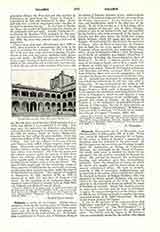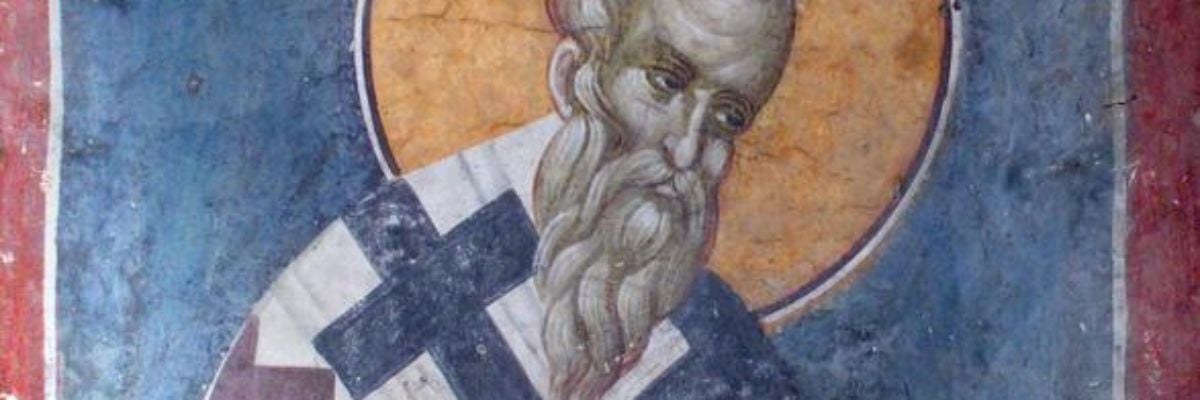

Salamis, EPIPHANIUS OF, b. at Besanduk, near Eleutheropolis, in Judea, after 310; d. in 403. While very young he followed the monastic life in Egypt. On his return to Judea he founded a monastery at Besanduk and was ordained to the priesthood. In 367 his reputation for asceticism and learning brought about his nomination as Bishop of Constantia (Salamis), the metropolis of the Island of Cyprus. For nearly forty years he fulfilled the duties of the episcopate, but his activity extended far beyond his island. His zeal for the monastic life, ecclesiastical learning, and orthodoxy gave him extraordinary authority; hence the numerous occasions on which his advice was sought, and his intervention in important ecclesiastical affairs. He went to Antioch, probably in 376, to investigate Apollinarianism and to intervene in the schism which divided that Church. He decided in favor of Bishop Paulinus, who was supported by Rome, against Meletius, who was supported by the episcopate of the East. In 382 he assisted at the Council of Rome to uphold the cause of Paulinus of Antioch. About 394, carried away by an apparently excessive zeal, he went to Jerusalem to oppose the supposed Origenism of the bishop, John. In 402 he was at Constantinople to combat the same pretended heresy of St. John Chrysostom. He died on his return journey to Cyprus.
It was at the instance of his correspondents that Epiphanius compiled his works. The earliest (374) is the “Ancoratus”, or “The Well-Anchored”, i.e. the Christian firmly fixed against the agitations of error. The Trinity and the dogma of the Resurrection are particularly treated by the author, who argues especially against the Arians and the Origenists. There are two symbols at the end of the work: the first, which is the shorter, is very important in the history of symbols, or professions of faith, being the baptismal creed of the Church of Constantia. The second is the personal work of Epiphanius, and is intended to fortify the faithful against current heresies. In the “Ancoratus” Epiphanius confines himself to a list of heresies. Some readers desired to have a detailed work on this question, and Epiphanius composed (374-7) the “Panarion” or “Medicine chest”, i.e. a stock of remedies to offset the poisons of heresy. This work is divided into three books comprising in all seven volumes and treating eighty heresies. The first twenty heresies are prior to Jesus Christ; the other sixty deal with Christian doctrine. In reality the number eighty may be reduced to seventy-seven, for among the twenty heresies prior to Christ only seventeen count. Three are generic names, namely Hellenism, Samaritanism, and Judaism. In the editions of the “Panarion” each heresy is numbered in order; hence it is customary to quote the “Panarion” as follows: Epiphanius, Haer. N (the number of the heresy). Necessarily much of the information in this great compilation varies in value. The “Panarion” reflects the character of Epiphanius and his method of working. Sometimes his ardor prevents him from inquiring carefully into the doctrines he opposes. Thus, on his own avowal (Haer., lxxi) he speaks of Apollinarianism on hearsay. At Constantinople he had to acknowledge to the Origenist monks whom he opposed that he was not acquainted with either their school or their books, and that he only spoke from hearsay (Sozomen, “Hist. eccl.”, VIII, xl). There is, however, in the “Panarion” much information not found elsewhere. Chapters devoted only to the doctrinal refutation of heresies are rare. As an apologist Epiphanius appeared generally weak to Photius.
The “Panarion” furnishes very valuable information concerning the religious history of the fourth century, either because the author confines himself to transcribing documents preserved by him alone or because he writes down his personal observations. With regard to Hieracas (Haer., lxvii), he makes known a very curious Egyptian sect by whom asceticism and intellectual work were equally esteemed. In connection with the Meletians of Egypt (Haer., xxviii), he has preserved important fragments of contemporary Egyptian history of this movement. With regard to Arianism (Haer., lxix), if he gives an apocryphal letter of Constantine, he transcribes two letters of Arius. He is the only one to give us any information concerning the Gothic sect of the Audians (Haer., lxx). He has made use of the lost report of the discussion between Photius (Haer., lxxi) and Basil of Ancyra. He has transcribed a very important letter from Bishop Marcellus of Ancyra (Haer., lxxii) to Pope Julius and fragments of the treatise of Acacius of Caesarea against Marcellus. With regard to the Semiarians (Haer., lxxiii), he gives in the Acts of the Council of Ancyra (358) a letter from Basil of Ancyra and one from George of Laodicea, and the stenographic text of the singular sermon of Meletius at the time of his installation at Antioch. In the chapter dealing with the Anomeans (Haer., xxxvi) he has preserved a monograph of Aetius.
For the first three centuries Epiphanius was compelled to use the only literary sources. Some of these have been preserved, such as the great anti-heretical work of St. Irenaeus of Antioch, “Contra Haereses”. Other ancient sources utilized by him have been lost, which gives exceptional value to his work. Thus he made use of the “Syntagma” of Hippolytus. The precise determination of all his sources is matter of controversy. His information is especially valuable with regard to the Samaritans (Haer., x-xiii), the Jews
(Haer., xiii-xx), the Ebionites (Haer., xxx), and their Gospel; with regard to the Gnostics Valentius (Haer., xxxi) and Ptolemaeus (Haer., xxxiii), whose letter to Flora he quotes; and with regard to the Scriptural criticism of Marcion. The work ends with a long exposition of the Catholic faith. A summary of the “Penarion” is perhaps the work of Epiphanius. A work entitled “Of Measures and Weights” (De mensuribus et ponderibus) has a more general interest than might be imagined from the title. For the time it is a real “Introduction” to Holy Scripture, containing the history of Biblical texts and Sacred archaeology. The treatise “On the Twelve Precious Stones” is an explanation of the ornaments of the high-priest’s breastplate (Ex., xxviii, 17). Mention must finally be made of two letters of Epiphanius preserved in a Latin translation.
In theological matters Epiphanius teaches the doctrine of the Catholic theologians of his time. In the vocabulary of Trinitarian theology he conforms to the language of the Greek Church. He speaks of three hypostases in the Trinity, whereas the Latins and the Paulicians of Antioch speak of one hypostasis in three persons. At bottom it was a mere matter of words, but for some time it occasioned theological dissensions. Epiphanius clearly teaches that the Holy Ghost proceeds from the Father and the Son. The doctrine that the Holy Ghost proceeds from the Father only prevailed later in the Greek Church. This teaching cannot be traced to Epiphanius (Ancoratus, 8). With regard to the constitution of the Church, he is one of the most explicit of the Greek theologians concerning the primacy of St. Peter (“Ancoratus”, 9; “Haer.”, lix, 7). Two passages on the Eucharist are famous because they are among those which most clearly affirm the “Discipline of the Secret“. The “Secret” was purely pedagogical and often neglected, consisting in grading the doctrinal initiation of catechumens and in not speaking before them of the Christian mysteries save in deliberately vague expressions. Hence the necessity of explaining the words of Epiphanius on the Eucharist (“Ancoratus”, 57; “Haer.”, xlii, 61). In these two passages, instead of quoting the words of the institution of the Eucharist, the author gives these: “Hoc meum est, hoc.” Epiphanius is one of the chief authorities of the fourth century for the devotion to the Blessed Virgin. He expresses himself on the subject in connection with two heresies, of which one diminished, while the other exaggerated, this devotion (“Haer.” lxxviii, lxxix). A circumstance of his life is well known in the history of images, namely the destruction of an image in the church of Bethel (“Letter to John of Jerusalem” in P.G., XLIII, 390).
His character is most clearly shown by the Origenist controversies, which demonstrated his disinterested zeal but also his quickness to suspect heresy, a good faith which was easily taken advantage of by the intriguing, and an ardor of conviction which caused him to forget the rules of canon law and to commit real abuses of power. He saw in Origen the chief cause of the heresies of his time, and especially of Arianism. He was particularly opposed to his allegorical method, his doctrines concerning the Son, in which he saw the subordination of the Son to the Father, his doctrines concerning the pre-existence of souls and the resurrection (“Ancoratus”, 54, 62; “Haer.”, lxiv). He did not confine himself to this condemnation of Origen. He reproached the monks and bishops of his time with accepting the Origenist errors. Thence resulted at the end of his life the conflict with John of Jerusalem and with St. John Chrysostom. Apart from the injustice of the controversy, he encroached on the jurisdiction of these bishops. He was made use of by Theophilus of Alexandria, the irreconcilable enemy of Chrysostom. The chief sources relative to this controversy are: St. Jerome, “Contra Joannem Hierosolymitanum” in P.L., XXIII, 355; Idem, “Ad Theophilum” in P.L., XXII, 736; Epiphanius, “Ad Joannem Hierosolymitanum” in P.G., XLIII, 379; Socrates, “Hist. eccl.”, VI, x-xiv; Sozomen, “Hist. eccl.”, VIII, xiv-xv. The chief editions of Epiphanius‘s works are those of Petavius (Paris, 1622); Greek text, Latin tr., and notes, reproduced with additions in P.G., XLI-XLIII; and of Dindorf (Leipzig, 1859-62), 5 vols., giving only the Greek text, improved in some parts.
LOUIS SALTET


